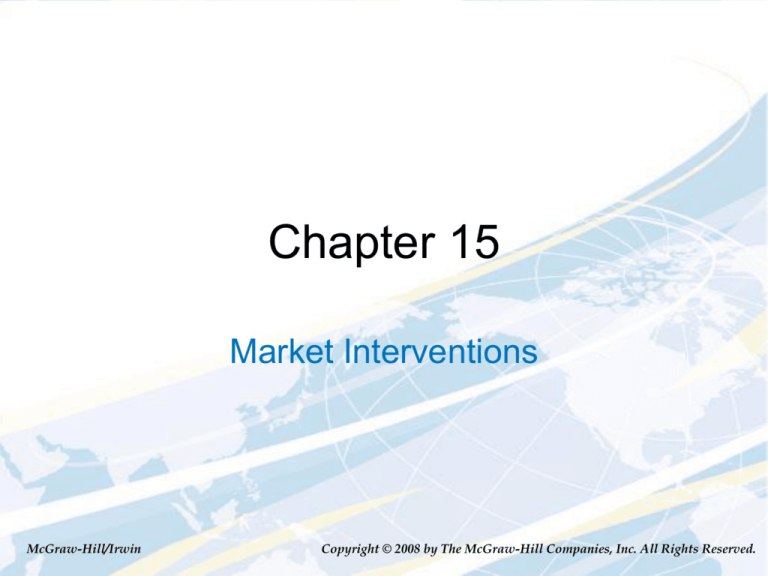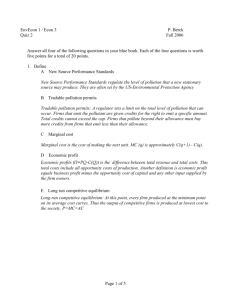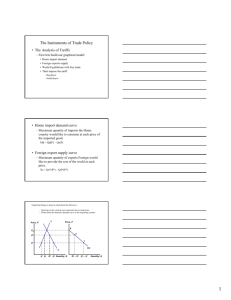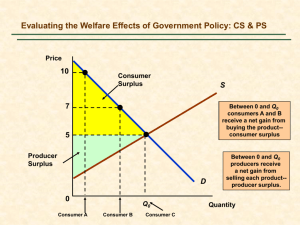
Chapter 15
Market Interventions
McGraw-Hill/Irwin
Copyright © 2008 by The McGraw-Hill Companies, Inc. All Rights Reserved.
Main Topics
The effect of a tax or subsidy
Policies designed to raise prices
Import tariffs and quotas
15-2
Taxes
A specific tax is a fixed dollar amount that must be
paid on each unit bought or paid
An ad valorem tax is a tax that is stated as a
percentage of the good’s price
The incidence of a tax indicates how much of the tax
burden is borne by various market participants
In studying the effects of taxes it’s important to
distinguish between the amount a consumer pays for a
good and the amount a firm receives
Use Pb for the amount a consumer pays, Ps for the amount a
firm receives
If the tax is T per unit, then Ps = Pb - T
15-3
The Burden of a Tax
Consider the effect of a specific tax of T dollars
per gallon paid by gas stations on their sales of
gasoline
Graphically, there are three ways to determine
the tax’s effect:
Shift the supply curve up by T
Shift the demand curve down by T
Use a wedge between the amounts consumers pay
and firms receive
All three methods yield the same results
Makes no difference whether the tax is levied
on consumers or producers
15-4
Effects of a Specific Tax
Shifting the supply curve is one way to determine a
specific tax’s effects
Demand curve remains unchanged
For any price paid by consumers, firms now receive
less than when there is no tax
Won’t be willing to supply as much as before
Supply curve with the tax is a distance T above the original
supply curve
New equilibrium price paid by consumers is price at
which the demand curve and new supply curve cross
Amount bought and sold falls
Price paid by consumers rises; price received by firms falls
In a competitive market the burden of a tax is shared
by consumers and firms
15-5
Price Paid by Consumers ($/gallon)
Figure 15.1: Effects of a Specific
Tax – Shifting the Supply Curve
ST
Increase in
Consumer Cost
per Gallon
S
Po + T
B
Pb
T
Po
A
Ps = Pb - T
Decrease in
Firms’ Receipts
per Gallon
D
QT
Qo
Gallons of Gas per Month
15-6
Tax Incidence
Incidence of a tax depends on the shapes of the
demand and supply curves
In general, the more elastic is demand and less
elastic is supply, the more of the tax is borne by firms
Es
Consumers' share of tax s
E Ed
Consumers bear the larger share of the tax when
demand is less elastic than supply
15-7
Figure 15.2: Incidence of a
Specific Tax – Two Special Cases
15-8
Figure 15.3: Effects of a Specific
Tax – Shifting the Demand Curve
15-9
Welfare Effects of a Tax
Use the no-tax demand and supply curve to measure
aggregate surplus in the absence of a tax
The tax reduces the amount bought and sold to the
quantity at which the distance between the supply and
demand curves is T
Since quantity bought and sold is higher without the
tax, so is aggregate surplus
To see the welfare effect of the tax, compute the
difference in aggregate surplus at the quantities with
and without the tax
The deadweight loss of taxation is the lost aggregate
surplus due to a tax
15-10
Welfare Effects of a Tax
Welfare effects can be used to assess winners and
losers from a tax or other policy
Graphical analysis of a tax shows:
Consumers and producers both lose, government gains tax
revenue
Society overall loses (deadweight loss)
Taxation can be used to move resources from the
private sector to the government
But the government receives less than private parties give up
Effect of a tax on welfare depends on what is done with the
revenue
Use algebra to compute the value of deadweight loss
from a tax
15-11
Figure 15.6: Welfare Effects of a
Specific Tax
15-12
Which Goods Should be Taxed?
Size of the deadweight loss from taxation of a good
depends on the shapes of the demand and supply
curves
If supply or demand is perfectly inelastic, for example, there is
no deadweight loss
The tax doesn’t change the quantity bought and sold
If either supply or demand is very inelastic, deadweight
loss caused by a tax will be low
Implies the government should aim to tax good for which the
deadweight loss from taxation will be low
If two goods have equal and constant marginal cost,
the good with less elastic demand should face a larger
tax
Distributional considerations can also affect the choice
of goods to tax
15-13
Figure 15.8: Taxation with No
Deadweight Loss
15-14
Sample Problem 1 (15.1):
The market demand function for corn is
Qd – 15 – 2P and the market supply
function is Qs = 5P -2.5, both measured in
billions of bushels per year. Suppose the
government imposes a $2.10 tax per
bushel. What will be the effects on
aggregate surplus, consumer surplus and
producer surplus? What will be the
deadweight loss created by the tax?
Subsidies and Their Effects
A subsidy is a payment that reduces the
amount that buyers pay for a good or increases
the amount that sellers receive
Subsidies can be either specific or ad valorem
(like taxes)
Often result from lobbying efforts
Usually increase sales of the affected goods
Cause deadweight loss
15-16
Subsidies and Their Effects
Consider the effect of a government subsidy of
T dollars for each gallon of ethanol produced
Can find the equilibrium with the subsidy by:
Shifting supply curve down by T
Shifting demand curve up by T
Looking for the quantity at which the demand curve
lies a distance of T below the no-subsidy supply
curve
Consumers pay T dollars less than firms
receive
Subsidy increases the amount bought and sold
15-17
Welfare Effects of Subsidies
Welfare analysis of a subsidy shows
consumers and producers both gain
The sum of the reduction in price to consumers
and the increase in price to firms exactly
equals the size of the subsidy
The side of the market whose demand or supply is
less elastic has a larger price change
Aggregate surplus falls
This is because the government incurs an expense,
the per-unit subsidy times the number of units sold
15-18
Figure 15.9: Deadweight Loss
of a Subsidy
15-19
Policies Designed to Raise Prices
Governments often attempt to manipulate markets to
benefit a particular group
When they want to help sellers in a market, they turn to
policies meant to raise prices
A price floor establishes a minimum price that sellers
can charge
A price support program raises the market price by
making purchases of the good, increasing demand
Production quotas impose limits on the quantity that
individual firms can produce
Voluntary production reduction programs offer firms
inducements to decrease their output voluntarily
15-20
Figure 15.12 (a): Price Floor
A price floor establishes
a minimum price that
sellers can charge
With minimum price of P,
quantity bought and sold
is Q1
15-21
Figure 15.12 (b): Price Support
A price support
program raises the
market price by making
purchases of the good,
increasing demand
Here, total sales are Q2:
Government purchases
Q2-Q1
Private buyers purchase
Q1
Price is P
15-22
Figure 15.12 (c): Production Quota
Production quotas
impose limits on the
quantity that individual
firms can produce
Total sales of Q1 are
achieved through a
production quota
Could also be achieved
through a voluntary
reduction program
15-23
Welfare Effects of Policies for
Raising Prices
Compare all four policies, each raising the
price of milk from P0 to P1
All create deadweight loss
Price support program is least efficient
Causes unused milk to be produced
Other three policies create equal deadweight
loss
Price floor and production quota have same
effects
15-24
Figure 15.13: Welfare Effects of
Policies for Raising Prices
15-25
Figure 15.13: Welfare Effects of
Policies for Raising Prices
15-26
Policies that Lower Prices
Sometimes governments adopt policies that are
designed to lower prices
To improve the well-being of buyers
Example: rent control laws
Reduces amount of the good available for purchase
Creates deadweight loss
Because buyers can’t purchase all they want at the
ceiling price, they may behave inefficiently
Increases deadweight loss
Example: extreme searching for rent-controlled apartments
Sellers have an incentive to inefficiently degrade the
quality of their products
15-27
Figure 15.16: Price Ceiling
15-28
Sample Problem 2 (15.12):
Suppose that the demand function for pizzas is
Qd = 65,800 – 1,200P and the supply function is
Qs = 4,000P – 20,000. Suppose the College
Student Party is elected and places a price
ceiling on pizza of $10 per pizza. How many
pizzas will be bought and sold? Assuming that
the highest willingness to pay consumers are the
ones to consume the supplied pizzas, what will
the effect be on the aggregate, consumer, and
producer surplus?
Import Tariffs and Quotas
Many countries use tariffs or quotas to
discourage imports
Example: the U.S. imposes a tariff on frozen orange
juice
A tariff is a tax on imports
A tariff is a tax on sellers in a market
But only on foreign sellers
A quota directly limits the total quantity of a
good that can be imported
In some cases governments use a mix of tariffs
and quotas
15-30
Tariffs
Analyzing the effects of a tariff, T, assume that
the country consumes a small share of the
world’s production of the good
Doesn’t affect world price, Pw
Import supply curve is horizontal at Pw
Tariff shifts the import supply curve upward by
the distance T
Foreign firms must now sell their goods for Pw + T
Price to domestic consumers rises, domestic
consumption falls
Amount sold by domestic producers increases
Imports decline
15-31
Figure 15.17: Effects of a Tariff
15-32
Welfare Effects of Tariff
The domestic government is concerned with domestic
aggregate surplus: the sum of consumer surplus,
domestic producer surplus, and government revenue
Under the tariff:
Consumers are worse off
Domestic consumers are better off
Government receives revenue equal to the quantity of imports
times the amount of the tariff
Domestic deadweight loss arises from reduction in total
consumption
The tariff allocates production inefficiently away from
foreign producers to domestic producers
15-33
Figure 15.18: Welfare Effects
of a Tariff
15-34
Sample Problem 3 (15.14):
The market demand function for corn is
Qd – 15 – 2P and the market supply
function is Qs = 5P -2.5, both measured in
billions of bushels per year. Suppose the
import supply curve is infinitely elastic at a
price of $1.50 per bushel. What would be
the welfare effects of a $0.50 per bushel
tariff?
Quotas
A quota limits the supply of imports to some maximum
quantity
The government can use either a quota or a tariff to
achieve a desired outcome of imports and domestic
price
Consumers and domestic firms are both as well off with the
quota as with the tariff
Difference is that government revenue is zero under the quota
Instead, revenue is earned by foreign firms lucky enough to
import their goods
Quota has lower domestic aggregate surplus than tariff
If government allocates import rights to domestic firms,
domestic firm’s producer surplus would increase
Domestic aggregate surplus would be the same for quota and
tariff
15-36
Figure 15.19: Effects of a Quota
15-37






